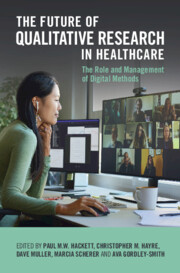Book contents
- The Future of Qualitative Research in Healthcare
- The Future of Qualitative Research in Healthcare
- Copyright page
- Dedication
- Contents
- Figures
- Tables
- Contributors
- Acknowledgements
- Chapter 1 Introduction to Digital Platforms and Digital Research Approaches, Encryption, Cybersecurity and Bandwidth
- Chapter 2 Doing Digital Qualitative Research
- Chapter 3 Using Video Diaries for Remote Observational Research
- Chapter 4 (In)Equitable Shifts
- Chapter 5 “To Be or Not to Be?” Qualitative Research upon and during a Pandemic Outbreak
- Chapter 6 Adopting Digital Methods
- Chapter 7 Lessons Learned Conducting Online Qualitative Interviews during Covid-19
- Chapter 8 Virtual Interviewing in the Age of Covid-19
- Chapter 9 Minimizing the Impact Technology Has on Interviewer–Interviewee Rapport
- Chapter 10 Participatory and Invasive Online Worlds
- Chapter 11 Using Online Survey Tools to Improve Access to International Experts
- Chapter 12 Refining Interview Protocols for Online Interviews on the Employment of Persons with Down Syndrome
- Chapter 13 Technology-Aided Programs to Support Leisure, Communication, and Daily Activities in People with Intellectual and Multiple Disabilities
- Chapter 14 Virtual Qualitative Data Collection
- Afterword
- Index
- References
Chapter 5 - “To Be or Not to Be?” Qualitative Research upon and during a Pandemic Outbreak
Published online by Cambridge University Press: 14 November 2024
- The Future of Qualitative Research in Healthcare
- The Future of Qualitative Research in Healthcare
- Copyright page
- Dedication
- Contents
- Figures
- Tables
- Contributors
- Acknowledgements
- Chapter 1 Introduction to Digital Platforms and Digital Research Approaches, Encryption, Cybersecurity and Bandwidth
- Chapter 2 Doing Digital Qualitative Research
- Chapter 3 Using Video Diaries for Remote Observational Research
- Chapter 4 (In)Equitable Shifts
- Chapter 5 “To Be or Not to Be?” Qualitative Research upon and during a Pandemic Outbreak
- Chapter 6 Adopting Digital Methods
- Chapter 7 Lessons Learned Conducting Online Qualitative Interviews during Covid-19
- Chapter 8 Virtual Interviewing in the Age of Covid-19
- Chapter 9 Minimizing the Impact Technology Has on Interviewer–Interviewee Rapport
- Chapter 10 Participatory and Invasive Online Worlds
- Chapter 11 Using Online Survey Tools to Improve Access to International Experts
- Chapter 12 Refining Interview Protocols for Online Interviews on the Employment of Persons with Down Syndrome
- Chapter 13 Technology-Aided Programs to Support Leisure, Communication, and Daily Activities in People with Intellectual and Multiple Disabilities
- Chapter 14 Virtual Qualitative Data Collection
- Afterword
- Index
- References
Summary
Qualitative research has much to contribute to our knowledge regarding lived experiences in a crisis, but most research in the context of crises is quantitative. Domains of qualitative research remain under-represented. Qualitative researchers bear the responsibility to voice populations who may be already struggling in a health crisis. This chapter aims to disentangle a few dilemmas of qualitative researchers in planning and implementing rigorous research upon and during an outbreak of a crisis. Initial dilemmas are whether and how to conduct a qualitative study during the outbreak or retrospectively; how may the researcher access study populations; and how the researcher may encourage participation. Other dilemmas concern obtaining informed consent, determining the right timing and length for the interviews, and creating interviewee--interviewer trust and intimacy. The dilemmas following data collection relate to the quality criteria of data analysis.
- Type
- Chapter
- Information
- The Future of Qualitative Research in HealthcareThe Role and Management of Digital Methods, pp. 52 - 67Publisher: Cambridge University PressPrint publication year: 2024

